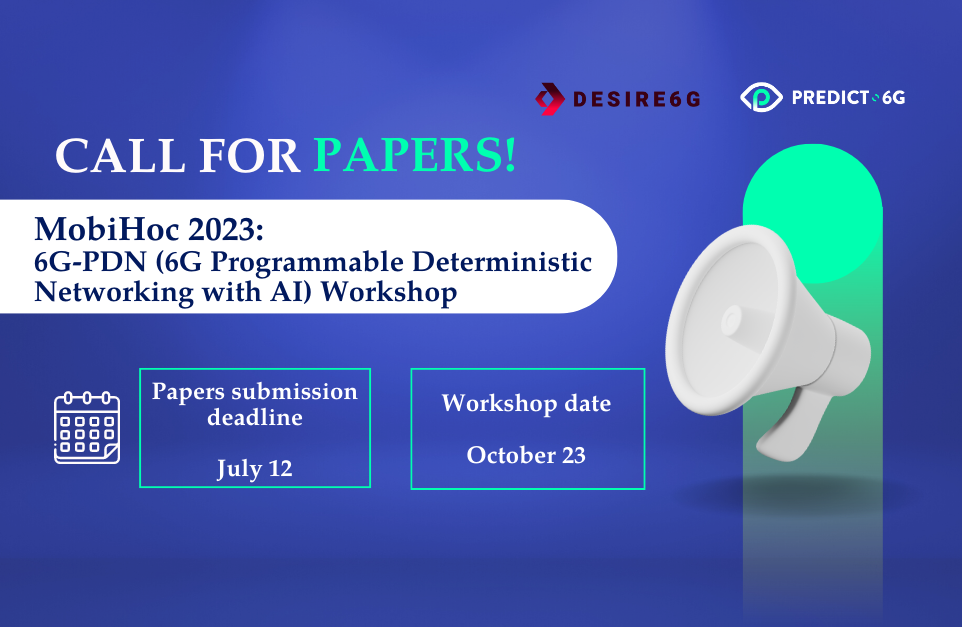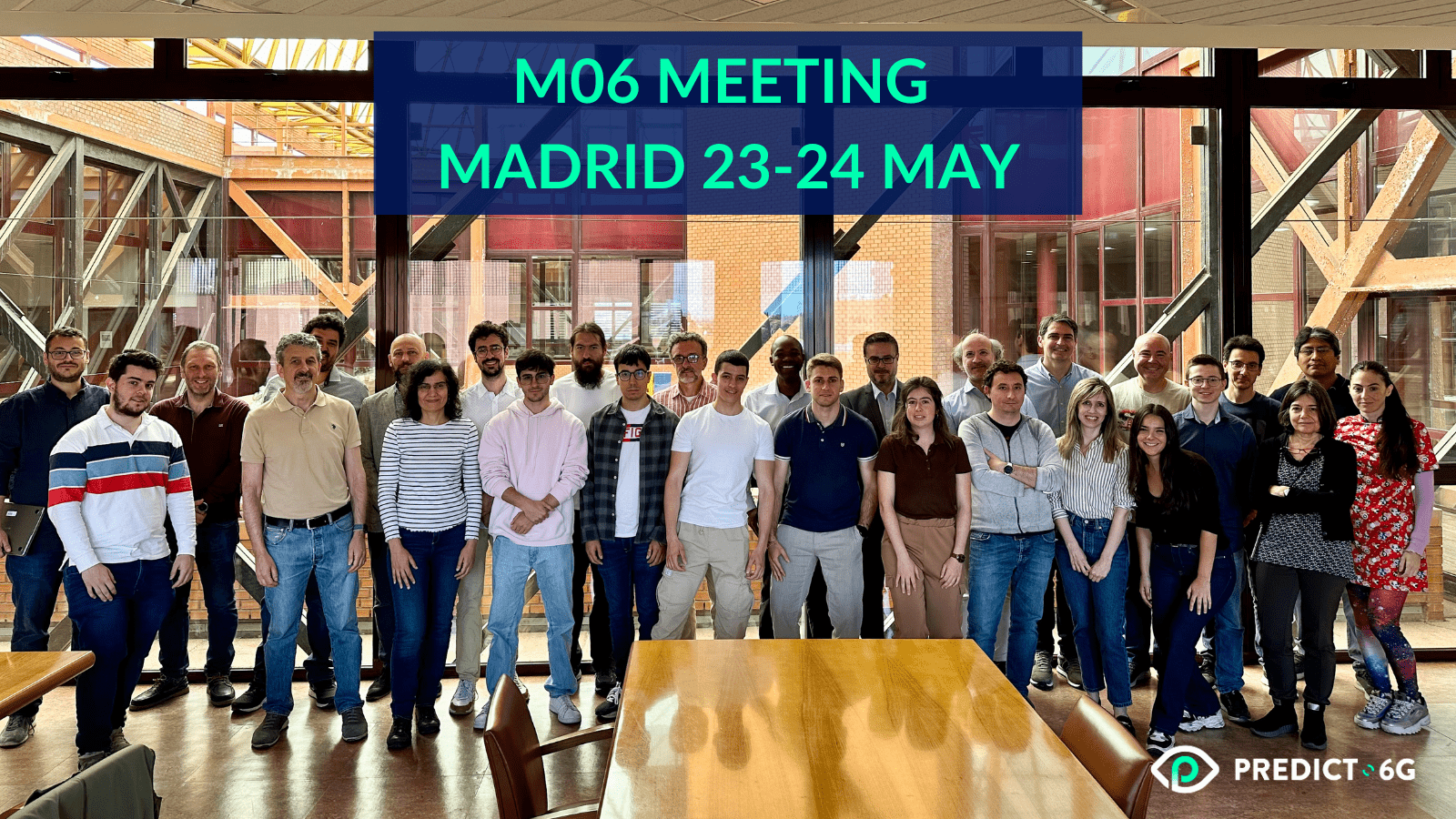PREDICT-6G at MedComNet 2023
The 21st Mediterranean Communication and Computer Networking Conference took place from the 13-15 of June 2023 in Ponza, Italy. Initiated in 2002, MedComNet is a forum for the presentation of new research results in the broad area of wired and wireless communication and computer networking.
On the 14th of June, PREDICT-6G was represented in the session “Edge, fog and cloud computing”. Professor Carla Fabiana Chiasserini and her colleagues from Politecnico di Torino (POLITO, Italy) presented their paper ¨TCP Connection Management for Stateful Container Migration at the Network Edge”, which addresses service continuity while migrating microservices. You can read the paper here.
Prof. Chiasserini also chaired the special session “Networking for a better Quality of Life”, with several presentations about the utilization of networking to enhance the wellbeing of citizens in terms of safety, privacy and health.
If you want to always stay updated about our project, subscribe to our newsletter and follow us on Twitter and LinkedIn!
MedComNet has obtained the technical co-sponsorship of the IEEE Communications Society (IEEE ComSoc), and accepted papers will be submitted for inclusion into IEEE Xplore.
Introducing DETERMINISTIC6G, a sister project of PREDICT-6G
One of the main intentions of PREDICT-6G is to quickly harness the multiplier capacity of initiatives advocating for 6G in Europe. Creating synergies with other projects funded by Horizon Europe under the same topic is a unique opportunity to build a real impactful European 6G landscape. Let’s discover one of them: DETERMINISTIC6G!
DETERMINISTIC6G aims at developing an end-to-end deterministic communication architecture enabling innovative 6G use cases. The concept of deterministic communication being the property of guaranteeing communication latency and reliability is central to the project. Ensuring sufficient end-to-end communication reliability remains a challenge for cellular networks in an industrial context.
A primary focus of the project will be on the interplay between future 6G networks with highly time-synchronized networks called Time Sensitive Networking (TSN). The challenge in these settings is that wireless systems like 6G can be subject to strong random variations, which is incompatible with technologies like TSN. DETERMINISTIC6G will tackle this problem by a combination of new wireless transmission design and advanced machine learning algorithms, leading to 6G wireless transmission with deterministic latency behavior. In addition to this, the project will also consider consequences and novel approaches for time synchronization, network security as well as the integration of computational nodes into the 6G systems.
Current developments in 5G integrate time-sensitive networking (TSN) and deterministic networking (DetNet) as deterministic communication mechanisms, however, they are not designed to support end-to-end (E2E) deterministic communication over heterogeneous infrastructures. Driven by pivotal 6G visionary use cases, the main concepts under-pinning the design of the DETERMINISTIC6G solution are:
- New architectures and protocols ensuring the efficient and secure integration of 6G systems into deterministic communication contexts.
- AI/ML based data-driven models for latency characterization in 6G wireless system
- leveraging novel digital twins of both 6G networks and cyber-physical systems to anticipate situational circumstances impacting determinism.
- Devise security-by-design mechanism for deterministic communication including the integration of edge computing and the support of OPC UA.
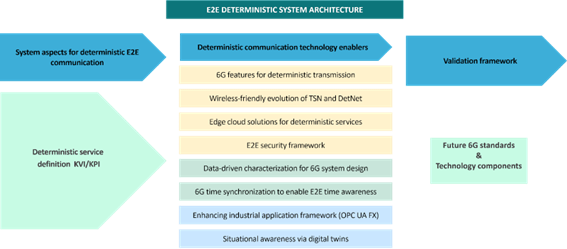
DETERMINISTIC6G builds on the wired deterministic communication standards to support end-to-end deterministic communication over heterogeneous networks. The expected outcomes of the project include:
- 6G architecture and interfaces allowing dynamic interactions in integrated heterogeneous infrastructure.
- Integration and interworking with deterministic standards over wired (TSN & DetNet) and wireless communication infrastructure.
- Concepts of an open controllability framework for time-critical services operating dynamically over multiple heterogeneous domains including edge computing as well as wired and wireless domains.
- An architecture for innovative 6G use cases based on security-by-design principles that provide capabilities to support deterministic wireless 6G transmission.
- New data-driven ML methods for 6G system providing probabilistic latency guarantees at run-time.
- E2E time awareness for supporting the deterministic operations.
- Unified service provisioning through integration with an advanced industrial application framework (OPC UA FX) to provide service to several industry verticals.
- Algorithms that leverage the information base of 6G digital twins and CPS digital twin in order to maintain E2E guarantees but also application-layer features such as safety.
If you want to stay updated about PREDICT-6Gt, subscribe to our newsletter and follow us on Twitter and LinkedIn!
Call for Papers: MobiHoc 2023
In the scope of the MobiHoc 2023 -the 24th International Symposium on Theory, Algorithmic Foundations, and Protocol Design for Mobile Networks and Mobile Computing-, which will be held in Washington DC, October 23-26, 2023, DESIRE6G and PREDICT-6G will co-organise the “6G-PDN (6G Programmable Deterministic Networking with AI)” workshop.
The aim of this workshop is to discuss the roadmap and challenges in the technological areas of deterministic communications and deep network programmability in 6G, to support future end-to- end time-critical applications. It also aims to bring together academic and industry researchers to stimulate discussions, introduce news ideas and technical solutions in the aforementioned areas and therefore contribute to the progress of 6G networking research.
Submitted papers may cover any of the following topics:
- Programmable data planes for TSN
- Network softwarization for 6G
- Programmable Networking Protocols
- Programmable SDN and NFV: languages and architectures (P4 and others)
- Hardware acceleration for programmable network functions
- Multitenant data planes
- Orchestration and Management of Software-Defined Deterministic Networks
- Control and Management of Data plane programmable devices
- Artificial intelligence for deterministic networks
- In network Machine Learning
- In-network service level tuning and optimization; QoS
- High precision traffic monitoring/telemetry
- Service assurance and fulfillment programmability
- Slicing for 6G
- Intent-based systems and Digital twinning applied in 6G.
- Reliability, time sensitiveness and predictability in 3GPP and WiFi systems.
Paper Submission deadline is July 12, 2023
You can read all the detailed information here.
If you want to always stay updated about our project, subscribe to our newsletter and follow us on Twitter and LinkedIn!
How Networks Can Help Machine Learning to Becoming (Truly) Pervasive
By Prof. Carla Fabiana Chiasserini, Politecnico di Torino, Italy
Prof. Carla Fabiana Chiasserini, member of the PREDICT-6G Consortium on behalf of Politecnico di Torino, Italy, highlights the challenges that the ubiquitous use of machine learning is posing and how the PREDICT-6G project is developing solutions to make it sustainable.
Machine Learning (ML) is all around: it is becoming an essential component of many user applications and network services. However, we all know that training and executing a ML model may exact a significant toll from the computational and network infrastructure due to its high resource demand. Consequently, current implementations of ML operations are heavy energy consumers, which makes the pervasiveness of ML we are witnessing not sustainable.
PREDICT-6G is committed to find breakthrough approaches to take and solve the challenge. Specifically, it has tackled the use of services for the optimal configuration of virtualized radio interfaces and of user applications at the network edge, for which ML can be the problem and the solution at the same time.
Network Function Virtualization (NFV) and edge computing are indeed disrupting the way mobile services can be offered through mobile network infrastructure. Third parties such as vertical industries and over-the-top players can now partner up with mobile operators to reach directly their customers and deliver a plethora of services with substantially reduced latency and bandwidth consumption. Video streaming, gaming, virtual reality, safety services for connected vehicles, and IoT are all services that can benefit from the combination of NFV and edge computing: when implemented through virtual machines or containers in servers co-located with base stations (or nearby), they can enjoy low latency and jitter, while storing and processing data locally.
The combination of NFV, edge computing, and an efficient radio interface, e.g., O-RAN, is therefore a powerful means to offer mobile services with high quality of experience (QoE). However, user applications are not the only ones that can be virtualized: network services such as data radio transmission and reception are nowa- days virtualized and implemented through Virtual Network Functions (VNFs) as well; and both types of virtual services, user’s and network’s, may be highly computationally intensive. On the other hand, it is a fact that computational availability at the network edge is limited. It follows that in the edge ecosystem, user applications and network services compete for resources, hence designing automated and efficient resource orchestration mechanisms in the case of resource scarcity is critical.
Further, looking more closely at the computational demand of virtualized user applications and at that of network service VNFs, one can notice that they certainly depend on the amount of data each service has to process, but they are also entangled. As an example, consider a user application at the edge and (de-)modulation and (de-)coding functions in a virtualized radio access network (vRAN). For downlink traffic, the application bitrate determines the amount of data to be processed by the vRAN; on the contrary, for uplink traffic, the data processed by the vRAN is the input to the application service. A negative correlation, however, may also exist: the more data compression is performed by a user application, the higher its computational demand, but the smaller the amount of data to be transmitted and the less the computing resources required by the vRAN. In a nutshell, a correlation exists between the amount of data processed/generated by virtual applications at the edge and network services VNFs, and such correlation can be positive or negative depending on the type of involved VNFs. Experimental tests performed within PREDICT-6G clearly show such correlation.
Then, owing to the complex involved dynamics, PREDICT-6G has developped a scalable reinforcement learning-based framework for resource orchestration at the edge, which leverages a Pareto analysis for provable fair and efficient decisions. The developed framework, named VERA [1], meets the target values of latency and throughput for over 96% of the observation period and its scaling cost is 54% lower than a traditional, centralized framework based on deep-Q networks.
[1] S. Tripathi, C. Puligheddu, S. Pramanik, A. Garcia-Saavedra and C. F. Chiasserini, "Fair and Scalable Orchestration of Network and Compute Resources for Virtual Edge Services," in IEEE Transactions on Mobile Computing, doi: 10.1109/TMC.2023.3254999.
If you want to always stay updated about our project, subscribe to our newsletter and follow us on Twitter and LinkedIn!
IEEE ICC 2023 “Sustainable Communications for Renaissance”
In the last week of May, Nextworks -member of the PREDICT-6G Consortium- participated in the IEEE ICC Conference as an exhibitor, with a dedicated booth where the company showcased R&D activities and results of past and ongoing research projects. It was a nice opportunity to discuss with partners and potential customers the latest research activities of the company in H2020, Horizon Europe and ESA projects, presenting results on management and orchestration for 5G/6G infrastructures, integration of satellite technology in 5G networks, edge-cloud continuum, IoT platforms and AI solutions for Industry 4.0 and Quantum Key Distribution.

The IEEE ICC is a capital event, one of the two flagship conferences of the IEEE ComSoc together with Globecom, attracting participants from dozens of countries around the world, both from Academia and Industry. This year’s edition, entitled “Sustainable Communication for Renaissance”, was held in Rome, at La Nuvola Convention Centre, and it brought together more than 2,000 delegates. The conference had 6G as central topic, addressing technical aspects like security, reliability and trustworthiness, network automation, radio interface, integration of Non-Terrestrial Networks, and discussing new use cases, vertical sectors and business scenarios for 6G, with a continuous and transversal attention to the sustainability of the network. Artificial Intelligence and Digital Twinning, crucial technology enablers for PREDICT-6G have been also widely discussed in several workshops and keynotes, with active participation from vendors and network operators. The exhibition area, with more than 30 booths set up by companies, research institutes, consortia and projects, was able to concentrate a heterogenous multitude of people, interested in a variety of topics and research activities, in one place.

In this context, Nextworks had the opportunity to present the PREDICT-6G concepts and technologies for predictable and deterministic services in 6G infrastructures, attracting attention from researchers and technology providers in the area of TSN and Industrial IoT. During the 5-day conference, there was the opportunity to discuss the project at different levels of technical detail, from the most basic concepts ("What is predictability?", "What is a deterministic network?") to the more complex topics, which are still being discussed even among the project participants. One of the main elements that sparked interest in the audience is the aim of PREDICT-6G of creating determinism across different network technologies in a transparent manner. Indeed, such an ambitious goal implies a strong cooperation between experts working on Data and Control planes, to address together challenges that covers aspects of packet ordering and time synchronisation, up to virtualization and abstraction for seamless orchestration of E2E deterministic connectivity over heterogenous networks.
Another important question received was “Why?”, what is the applicability of PREDICT-6G. Determinism is a crucial characteristic for industrial networks and in the era of mobility and network pervasiveness, manufacturing industries are more and more connected and remotely managed. As such, they are perfect early adopter for PREDICT-6G technologies. The presence of big manufacturers in PREDICT-6G consortium will be crucial to identify their key requirements and validate the solutions that will be developed in the project in realistic environments able to replicate operational conditions.
If you want to always stay updated about our project, subscribe to our newsletter and follow us on Twitter and LinkedIn!
PREDICT-6G at Data Week 2023
The Data Week is the spring gathering of the European Big Data and Data Driven AI research and innovation communities. The 2023 edition ¨Data meets infrastructure at the edge¨ took place from the 13th to the 19th of June 2023 in Luleå, Sweden. During the event, the participants shared knowledge and results, discussed topics of common interest, found synergies, built new collaborations, and identified new challenges and recommendations. Data Week is also a great opportunity to link the communities and their results to European policies and market needs and brings European initiatives and activities closer to local communities.
On the 14th of June, PREDICT-6G and VERGE, both EU projects supported by the SNS JU and funded under the Horizon Europe programme, co-organised the session “AI-native data management for robustness and sustainability”. In this session, the two projects alongside a very promising start-up (QBEAST), a well-known European research institute (Insight-centre), and corporation programme (Intel Ignite) elaborated on several aspects of what are the expected benefits brought by AI in different fields.

Dr Valerio Frascolla, Director of Research and Innovation at Intel and PREDICT-6G Innovation Manager, ran the session and Prof. Antonio de la Oliva, PREDICT-6G Coordinator, gave the presentation “Determinism and Robustness as pillars of future production sites”, focusing on the main aspects of PREDICT-6G. “The workshop was very interesting. It has been a pleasure to confront our ideas with people from several industries and backgrounds which are not always aligned with our view”, said Prof. de la Oliva.
A panel run by Dr Frascolla was held at the end of the session, to answer questions from the audience and exchange points of view with and among speakers. Attendance of the session was people from industry academia, European Commission and other public bodies.
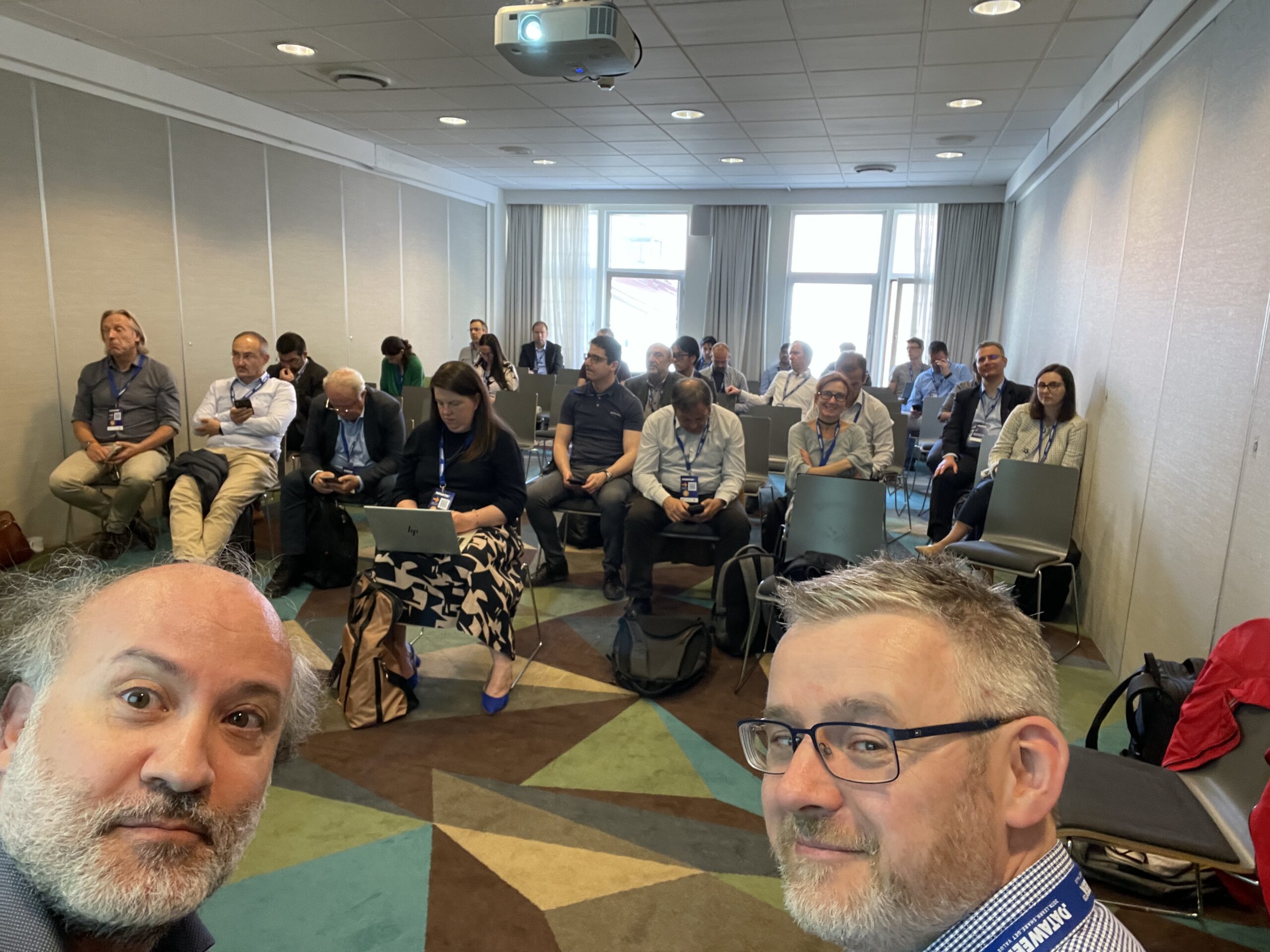
If you want to always stay updated about our project, subscribe to our newsletter and follow us on Twitter and LinkedIn!
Data Week 2023 is co-organised by BDVA and EUHubs4Data project in collaboration with the Research Institutes of Sweden (RISE). Data Week is the combination of local and regional events organised by the BDVA i-Spaces [i-Spaces] in the framework of the EUHubs4Data project and the main European event.
PREDICT-6G at the 2023 EuCNC & 6G Summit
The 2023 EuCNC & 6G Summit took place from the 6th to the 9th of June 2023 in Gothenburg, Sweden. Combining two of Europe’s premier events in communication networks: the European Conference on Networks and Communications (EuCNC), supported by the European Commission, and the 6G Summit, originated from the 6G Flagship programme in Finland, one of the very first in its area; the event has become one of the most important in the sector. It brings together cutting-edge research and world-renown industries and businesses to present, discuss and showcase the latest developments in the sector.
PREDICT-6G attended numerous exciting keynotes, panels, sessions, workshops, tutorials, as well as the outstanding social programme. It also visited the exhibition, gathering more than 70 exhibitors, many of which were projects funded by EU R&I programmes displaying their scientific and technological achievements.
On the 6th of June, Dr. Valerio Frascolla had the pleasure to chair the workshop “Future deterministic programmable networks for 6G”, a joint endeavour of PREDICT-6G and its two sister projects DESIRE6G and DETERMINISTIC6G. With the aim of opening a space for debate on the different approaches to determinism being pursued, the workshop brought together speakers from the three projects to present the main research topics being investigated to an audience of 70 people.

Dr Afif Osseiran, vice-chair of 5G-ACIA, gave a keynote address ¨5G-ACIA: learnings on 5G for industries” highlighting the lessons learnt on 5G networks for the industry, which provided a great perspective in the development of 6G.
The workshop wrapped up with a panel discussion enlightening how the future deterministic 6G networks will be realised. “The workshop was important not only for the PREDICT-6G team, but also for a broader audience as it reported the work of several EU-funded projects”, says Dr Frascolla.
On behalf of PREDICT-6G, Milan Groshev presented an special session on the importance of predictability determinism in 6G in the Speakers’ Corner set up in the exhibition. “It was an enormous pleasure to represent our project and see the interesting presentations from different researchers that work on deterministic networks. We had a great discussion regarding what predictability and determinism are and the existing open challenges that have to be addressed in order to bring this concept to the wireless domain” stated Groshev.
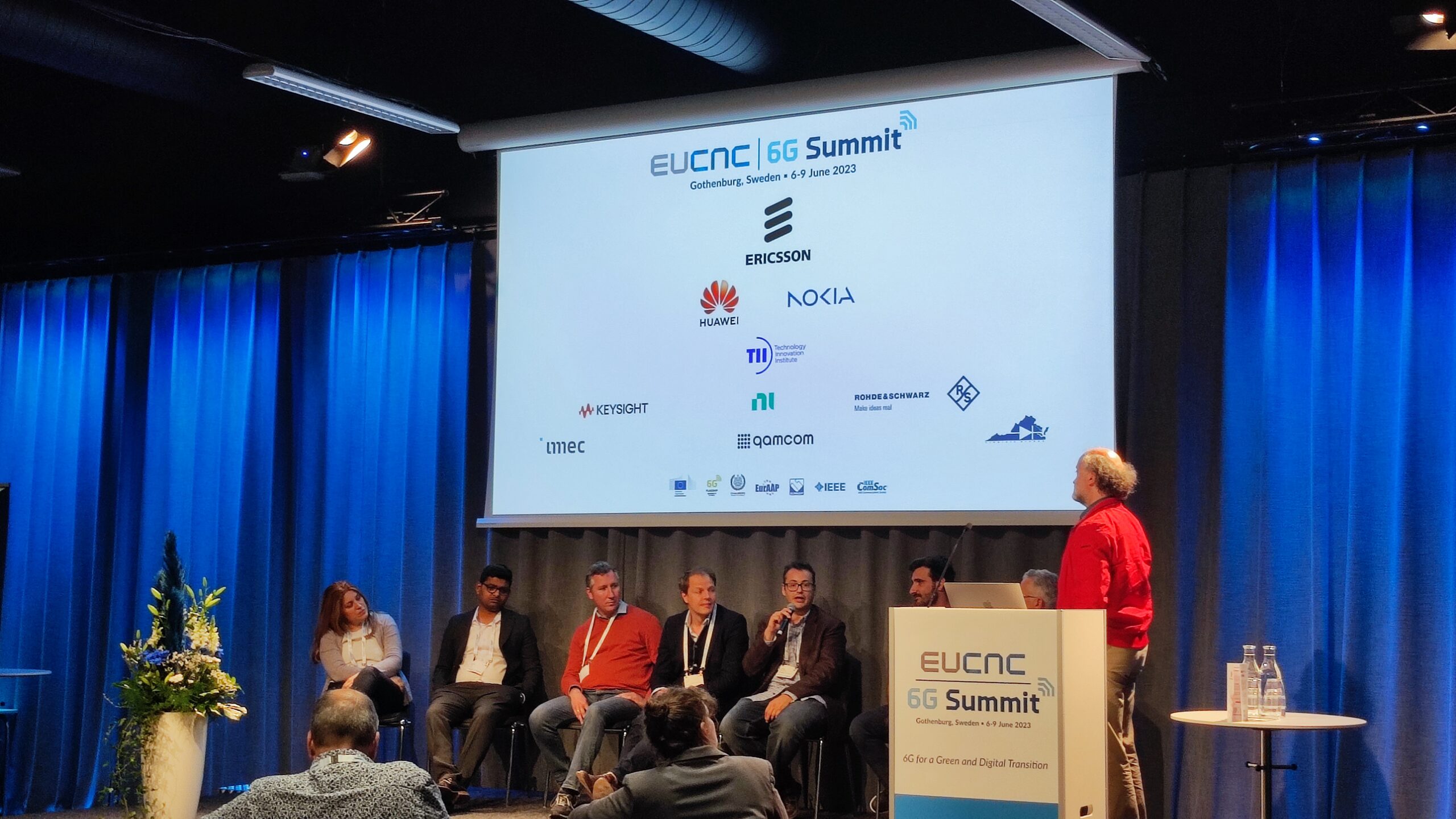
As the event concluded, Antonio de la Oliva, PREDICT-6G coordinator weighed in on the last days: "I have been very happy to participate in the 2023 edition of EuCNC, tightening relations with our peer research projects and the overall ecosystem. Worth to say, this has been one of the best organised EuCNCs I have participated in”.
You can find the workshop presentations here.
The 2023 EuCNC & 6G Summit is sponsored by the IEEE Communications Society (ComSoc), the European Association for Signal Processing (EURASIP) and the European Association on Antennas and Propagation (EurAAP) and focuses on all aspects of telecommunications ranging from 5G deployment and mobile IoT to 6G exploration and future communications systems and networks, including experimentation and testbeds, and applications and services. It brings together cutting-edge research and world-renown industries and businesses, globally attracting in the last years more than 1 300 delegates from more than 40 countries all over the world.
If you want to stay updated about PREDICT-6Gt, subscribe to our newsletter and follow us on Twitter and LinkedIn!
PREDICT-6G hosts its second plenary meeting
The 23rd and 24th of May, the PREDICT-6G Consortium met in Madrid to host its second plenary meeting . Two fruitful days used by the members of the team to review what we have accomplished over the past five months and to set the roadmap for the coming months.
The meeting, hosted at the premises of the Universidad Carlos III de Madrid (the coordinator of the Project), took place over two days, during which the Work Package and Tasks leaders presented the progress made to date, as well as the future impulses needed to achieve each of the objectives set. There was also time to plan for PREDICT-6G's upcoming participation in international conferences, such as the European Conference on Networks and Communications 2023 (EuCNC) where the project will organize the joint workshop titled “Future deterministic programmable networks for 6G”.
“During the Madrid May meeting we have pushed substantially the work on PREDICT-6G, clarifying the key technical aspects on the control and data plane to realise multi-domain, multi-technology determinism”, said Antonio de la Oliva, the coordinator of PREDICT-6G.
Finally, the consortium visited the 5Tonic Open Lab, where two of the project’s use cases will be tested: the Multi-domain deterministic communication use case and the Smart Manufacturing use case.
If you want to stay updated about PREDICT-6Gt, subscribe to our newsletter and follow us on Twitter and LinkedIn!
Future deterministic programmable networks for 6G, a joint workshop
The three EU funded project DESIRE6G, DETERMINISTIC6G and PREDICT6G are developing new technologies to tackle determinism at a global scale in the yet to be defined 6G architecture.
A joint workshop titled "Future deterministic programmable networks for 6G" is organized by these projects at the European Conference on Networks and Communications 2023 (EuCNC). EuCNC focuses on telecommunications aspects ranging from 5G deployment to 6G exploration and future communications systems and networks. The aim of this workshop is to open a space for discussion of the different approaches to determinism that these projects are choosing while discussing open points and possible collaboration topics. The workshop takes place on Tuesday, 6 June 2023, 14:00-17:30 where Dr. Afif Osseiran, vice-chair 5G-ACIA gives a Keynote on the “learnings on 5G for industries”. Members of the three projects will present key research topics being investigated under these projects. A panel discussion will wrap up the workshop enlightening how the future deterministic 6G networks will be realized.
Check the programme here.
If you want to stay updated about PREDICT-6Gt, subscribe to our newsletter and follow us on Twitter and LinkedIn!
2023 EUCnC & 6G Summit 6G for a Green and Digital Transition
PREDICT-6G, together with DETERMINISTC-6G and DESIRE-6G, will present a joint workshop titled “Future deterministic programmable networks for 6G” in the context of the 2023 EUCnC & 6G Summit, which will take place the 6-9 of June in Gothenburg, Sweden.
The workshop will address the concepts being developed by the three projects, which will enable future 6G deterministic programmable networks, and will open a space for discussing the different approaches to determinism explored by each project. Experts on the field will be invited to provide their view on the different deterministic and programmable approaches for WLAN, IEEE 802.1TSN, DetNet, OPC, and 3GPP TSC.
If you want to stay updated about PREDICT-6Gt, subscribe to our newsletter and follow us on Twitter and LinkedIn!



